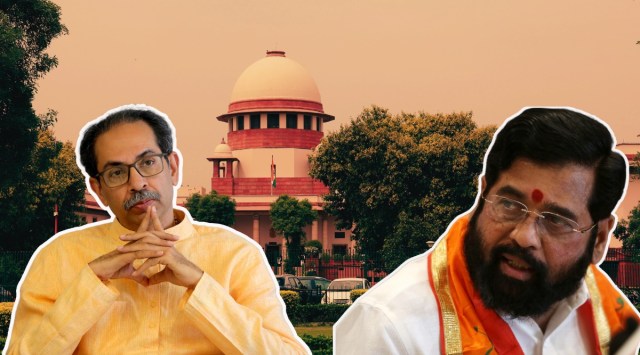
The Supreme Court’s decision on the Shiv Sena crisis may not have much to add to the status quo in Maharashtra. The Supreme Court rightly concluded that the resignation of Uddhav Thackeray could not be declared invalid, and hence, despite various irregularities, his government cannot be reinstated. Yet, at least one aspect of the judgment is likely to be crucial to the future of Indian political parties.
When the Maharashtra political crisis was on the boil last year, Thackerey controlled the party organisation, while the Shinde faction claimed the support of the majority of elected legislators (legislature party). Underneath the procedural nuances, lay a fundamental constitutional question. It goes to the heart of how we imagine the role of political parties in our democracy: Who should have supremacy – the legislature party or the party organisation?
The Westminster parliamentary system was suspicious of the influence of extra-parliamentary party organisations. According to the conventional idea of the Westminster system, once the elections are concluded, party organisations should step aside, and let elected legislators define the party’s path. The sanctity of the legislature demands that party organisations should not pull strings from the backroom of politics. The four walls of the legislature, the argument goes, need to be protected from such extra-parliamentary influences. But even in the UK, parliamentary democracy has moved away from the classical Westminster system by recognising the fusion of the organisational and parliamentary wings of parties. For instance, the leaders of major parties, who in turn select their Chief Whips, are elected by the ordinary members of the party organisation. In this way, the parliamentary lives of parties are no longer isolated from the demands of party organisations.
The Supreme Court, too, differed from the conventional Westminster view. Rightly so. The Court held that the power to issue a “whip” resides with party organisations, not the legislature party. The supremacy of the organisational party, not the classical Westminster view, is also constitutionally more appropriate. The classical view of the Westminster system, formulated before the advent of the universal franchise, does not sit well with mass democracies. In mass democracies, such as India, candidates are set up by party organisations. Their campaigns revolve around the party’s programmes or leaders. To a large extent, the candidate owes her election to the organisational wing of the party. Thus, party organisations, not individual legislators, secure a democratic mandate. Indeed, this is the logic of the anti-defection amendment.
It is also desirable that voters vote for parties, not individual candidates. Party organisations make the electoral competition meaningful by providing cohesive choices to the electorate. The role of parties does not end at elections. If a legislature is conceptualised as a collection of hundreds of individual lawmakers instead of a handful of parties, regular law-making would become impossible. Moreover, in a parliamentary system, the government needs the legislature’s confidence. Parties ensure government stability. Similarly, united Opposition parties are likely to provide a more powerful check against the excesses of the government. Party organisations provide the glue for this unity. If we sever the links between the legislators and their party organisations, the democratic justification for parliamentary accountability withers away. As the Court states, it may be artificial to sever the “figurative umbilical cord” that connects the legislators to their political parties. Party organisations link the state with society, thus enabling democratic self-rule. They should not be seen as an undesirable influence on the functioning of the legislature. Instead, the role of party organisations should be embraced within our constitutional system.
Recognising the constitutional role of party organisations comes with a significant challenge. Indian party organisations are severely under-institutionalised. The party constitutions — observed more in violation than in obedience — do not clearly establish the role and powers of internal organs. They also tend to confer excessive personal discretion on party leaders. There is little, if any, legal regulation of how parties should organise their internal structures. If parties are meant to perform a constitutional function, they cannot continue to be mere personal fiefdoms of individual leaders.
Given the lack of institutional rules and processes in Indian party organisations, the speakers or courts may face tricky questions on which neither the law nor the party’s rules provide any clarity. For instance, where exactly does the authority to discipline lie within the party? What processes should party organisations follow before issuing a whip? A whip — a political device — acquires a legal character in the context of the anti-defection amendment. After all, for a whip to have the effect of disqualification of a legislator, it should be a legally valid whip. The legal validity of the whip would inevitably require the speakers and courts to look into the internal functioning of parties. It may also lead to the legal examination of how party organisations issue whips. The courts, in future cases, should not shy away from imposing at least minimal constitutional-procedural constraints on the internal workings of Indian parties.
The full import of the decision is yet to be seen. A lot depends on how the speakers and the courts will evaluate the validity of whips. However, the judgment opens the doors for courts to crack open the political backrooms of intra-party functioning in future cases. The recognition of the constitutional role of party organisations, after all, should accompany more significant legal constraints on party organisations. Opening up the black box of intra-party processes, and subjecting it to constitutional constraints, may facilitate greater institutionalisation of intra-party processes. At least, one can hope so.
The writer is a PhD Candidate at the University of Cambridge